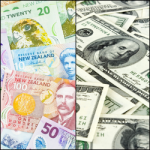Australian dollar fell against its US counterpart on trading Thursday, after a report showed manufacturing activity in worlds second largest economy slowed down in February, which dampened demand for high-yielding assets.
AUD/USD fell to a session low at 0.8937 at 4:10 GMT, after which consolidation followed at 0.8955, losing 0.52% for the day. Support was likely to be received at February 13th low, 0.8928, while resistance was to be encountered at February 19th high, 0.9044. The MSCI Asia Pacific Index of stocks declined 1.2%.
According to preliminary data by HSBC Holdings Plc and Markit Economics, their manufacturing Purchasing Managers’ Index (PMI) for China dropped to a reading of 48.3 in February, or the lowest level in seven months, after a month ago the final value of the gauge was 49.5. Experts had anticipated that the index will remain unchanged this month. China is Australias largest export partner.
Meanwhile, in the United States, a report by the Department of Commerce revealed that producer prices increased 0.2% in January, exceeding analysts’ expectations of a 0.1% gain and after rising 0.1% in the preceding month. In annual terms, the producer price index (PPI) advanced to 1.2% last month, in line with analysts’ forecasts, while December’s rate has been revised down to 1.1%.
Core producer prices, which exclude the volatile food and energy categories, rose 0.2% in January, outstripping analysts’ projections of a 0.1% gain, following another 0.3% increase during the previous month.
The index of consumer prices in the country probably rose 0.1% in January compared to December, according to the median estimate of experts, slowing down in comparison with a 0.2% gain in December compared to November. Annualized consumer price inflation probably reached 1.6% last month, after it was 1.5% in December. The official figures are expected to be released at 13:30 GMT. Faster than expected pace of inflation will certainly provide support to greenbacks demand.
At the same time, the minutes of Federal Reserve Banks policy meeting on January 28th-29th showed that several policy makers said in “the absence of an appreciable change in the economic outlook, there should be a clear presumption in favor” of continuing to pare back the central bank’s monthly monetary stimulus by 10 billion USD at each meeting.
As the rate of unemployment decreases at a faster than expected pace, even while other labor-market indicators signal weakness, banks policy makers agreed that it would “soon be appropriate” to revise their guidance about the time horizon of record-low borrowing costs.
The need to change the unemployment threshold has been underscored, but however, policy makers expressed different opinions about how to clarify their guidance. Some officials supported the idea of keeping some form of quantitative guidance, “while others preferred a qualitative approach that would provide additional information regarding the factors that would guide the Committee’s policy decision,” the Fed minutes revealed.
“My preference would be, as we go through the threshold on unemployment, to just drop reference to these explicit thresholds and go back to a more normal policy,” Federal Reserve President for St. Louis, James Bullard, who does not vote on monetary policy this year, said today in Washington.
“Even if we get some weaker U.S. economic data, the Fed will not easily stop tapering and that’s being priced in by the market,” said Noriaki Murao, the New York-based managing director of the marketing group at the Bank of Tokyo-Mitsubishi UFJ Ltd., cited by Bloomberg. “The dollar is supported.”
Elsewhere, the Aussie was lower against the euro, with EUR/AUD cross gaining 0.18% on a daily basis to trade at 1.5288 at 8:14 GMT. AUD/NZD was losing 0.38% to trade at 1.0838 at 8:17 GMT. The pair fell from a session high at 1.0885.





